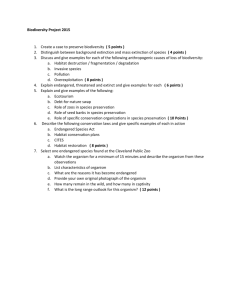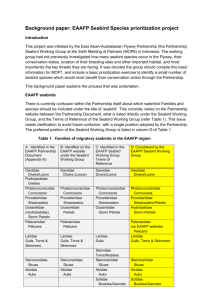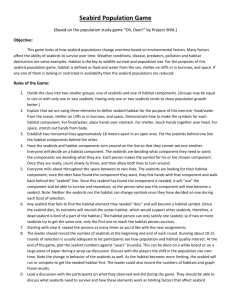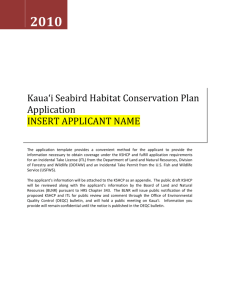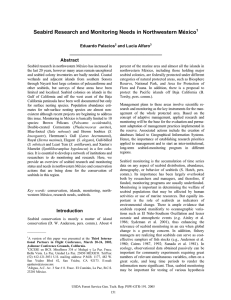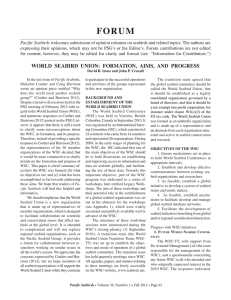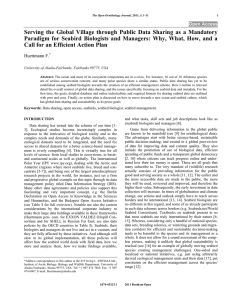Why is the Kaua`i Seabird Habitat Conservation Program (KSHCP)
advertisement
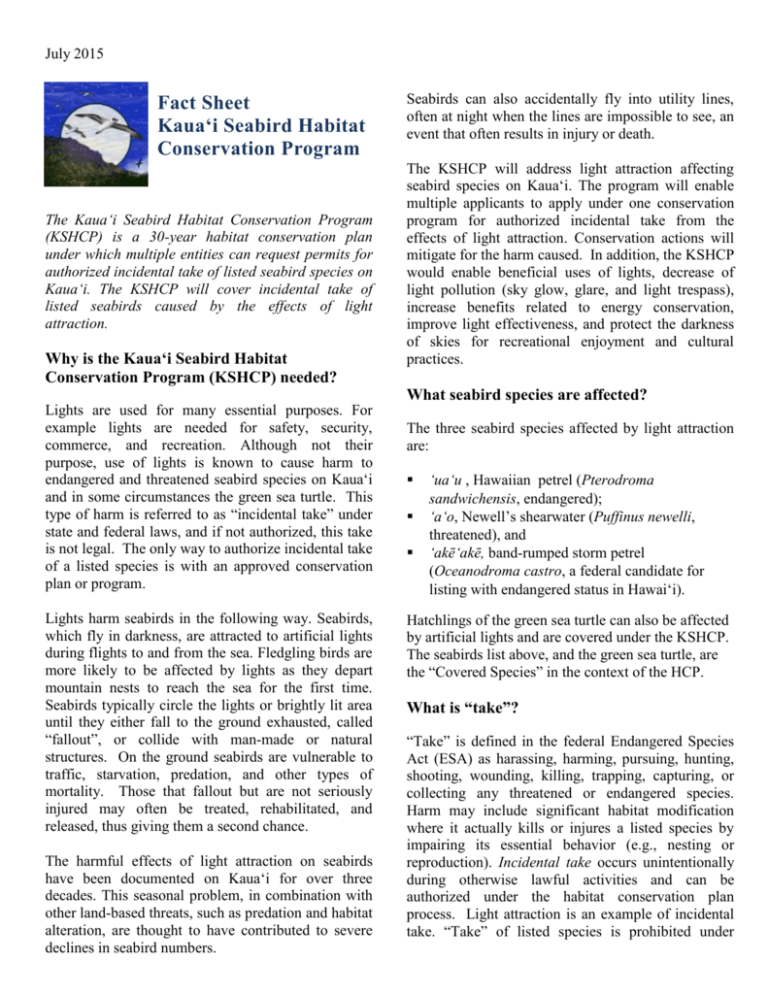
July 2015 Fact Sheet Kaua‘i Seabird Habitat Conservation Program The Kaua‘i Seabird Habitat Conservation Program (KSHCP) is a 30-year habitat conservation plan under which multiple entities can request permits for authorized incidental take of listed seabird species on Kaua‘i. The KSHCP will cover incidental take of listed seabirds caused by the effects of light attraction. Why is the Kaua‘i Seabird Habitat Conservation Program (KSHCP) needed? Seabirds can also accidentally fly into utility lines, often at night when the lines are impossible to see, an event that often results in injury or death. The KSHCP will address light attraction affecting seabird species on Kaua‘i. The program will enable multiple applicants to apply under one conservation program for authorized incidental take from the effects of light attraction. Conservation actions will mitigate for the harm caused. In addition, the KSHCP would enable beneficial uses of lights, decrease of light pollution (sky glow, glare, and light trespass), increase benefits related to energy conservation, improve light effectiveness, and protect the darkness of skies for recreational enjoyment and cultural practices. What seabird species are affected? Lights are used for many essential purposes. For example lights are needed for safety, security, commerce, and recreation. Although not their purpose, use of lights is known to cause harm to endangered and threatened seabird species on Kaua‘i and in some circumstances the green sea turtle. This type of harm is referred to as “incidental take” under state and federal laws, and if not authorized, this take is not legal. The only way to authorize incidental take of a listed species is with an approved conservation plan or program. Lights harm seabirds in the following way. Seabirds, which fly in darkness, are attracted to artificial lights during flights to and from the sea. Fledgling birds are more likely to be affected by lights as they depart mountain nests to reach the sea for the first time. Seabirds typically circle the lights or brightly lit area until they either fall to the ground exhausted, called “fallout”, or collide with man-made or natural structures. On the ground seabirds are vulnerable to traffic, starvation, predation, and other types of mortality. Those that fallout but are not seriously injured may often be treated, rehabilitated, and released, thus giving them a second chance. The harmful effects of light attraction on seabirds have been documented on Kaua‘i for over three decades. This seasonal problem, in combination with other land-based threats, such as predation and habitat alteration, are thought to have contributed to severe declines in seabird numbers. The three seabird species affected by light attraction are: ‘ua‘u , Hawaiian petrel (Pterodroma sandwichensis, endangered); ‘a‘o, Newell’s shearwater (Puffinus newelli, threatened), and ‘akē‘akē, band-rumped storm petrel (Oceanodroma castro, a federal candidate for listing with endangered status in Hawai‘i). Hatchlings of the green sea turtle can also be affected by artificial lights and are covered under the KSHCP. The seabirds list above, and the green sea turtle, are the “Covered Species” in the context of the HCP. What is “take”? “Take” is defined in the federal Endangered Species Act (ESA) as harassing, harming, pursuing, hunting, shooting, wounding, killing, trapping, capturing, or collecting any threatened or endangered species. Harm may include significant habitat modification where it actually kills or injures a listed species by impairing its essential behavior (e.g., nesting or reproduction). Incidental take occurs unintentionally during otherwise lawful activities and can be authorized under the habitat conservation plan process. Light attraction is an example of incidental take. “Take” of listed species is prohibited under section 9 of the Endangered Species Act and Hawai‘i Revised Statutes §195D-4. (ESA), b) Incidental Take License (ITL) under State of Hawai‘i Revised Statues §195D-4. What is a Habitat Conservation Plan (HCP)? PERMIT ISSUING AGENCIES: The U.S. Fish and Wildlife Service (USFWS) and the Hawai‘i Department of Land and Natural Resources (DLNR), Board of Land and Natural Resources. COVERED ACTIVITIES: The KSHCP would cover the placement and maintenance of lights with potential to cause incidental take. The types of applicants expected to request authorized take include resorts and condominiums, small businesses, and state agencies. Any entity with lighting that has potential to cause incidental take can apply under the KSHCP. HCP COVERAGE AREA (PLAN AREA): The potential terrestrial coverage of the HCP area could include any land parcel within the Island of Kaua'i. It is anticipated that most applicant facilities will be located along the coastal areas of Kaua‘i where most of the development occurs. Conservation actions are expected to occur at specific, select areas containing seabird breeding presence. Hawaiian petrel, Brenda Zaun USFWS A habitat conservation plan, or HCP, describes how a permit applicant will, to the maximum extent possible, minimize and mitigate the potential incidental take of a listed species that may result from its activities and facilities. The issuance of incidental take permits via the HCP process authorizes the take of the listed species, not the activities that result in the take. Section 10 of the ESA and Hawai‘i Revised Statutes §195D-21 provide for the HCP process to allow development or activities to proceed while promoting the conservation of listed species. DURATION OF PROGRAM: 30 years. PERMIT HOLDER: Each approved entity would sign state and federal permits requiring them to be responsible for implementation of avoidance, minimization, and take monitoring, as well as for contributing HCP fees to fund mitigation, HCP administration, take monitoring, and mitigation monitoring. In order for HCPs to be approved, they must include descriptions of the covered species and activities, measures to avoid and minimize take to the maximum extent practicable, measures to mitigate for unavoidable take, and measures to monitor and report progress. Adaptive management is also part of the HCP process, particularly when there is uncertainty pertaining to species biology, status, take estimates, or the efficacy of proposed mitigation measures. ESTIMATED TAKE LEVELS: Based on the available data and information, the amount of take that would be potentially authorized under the KSHCP are listed below. Species ‘a‘o ‘ua‘u ‘akē‘akē A Snapshot of the Proposed Kaua‘i Seabird HCP PERMITS: a) Incidental Take Permit (ITP) under Section 10 of the federal Endangered Species Act Estimated Annual Fledgling Take ~80-150 4-8 1-2 The take amounts are preliminary only and will be determined by amounts requested by applicants and authorized by the USFWS and the DLNR. 2 Preferred KSHCP mitigation areas are located in the north portion of the island along the Nā Pali coast because that area contains high amounts of active ‘a‘o colonies. Additional areas for conducting seabird colony creation and translocation will be identified as needed. Harmful effects to listed plants or other animals as a result of the compensatory mitigation plan are not expected. Plant and animal protection protocols, including pre-work surveys and protective measures, would be implemented during all field work to avoid harm to listed plant and animal species. AVOIDANCE AND MINIMIZATION: Impacts to the Covered Species are required to be minimized to the maximum extent practicable and would entail: 1) removing or turning off problematic lights; and 2) minimizing impacts by the use of seabird-friendly lighting. Seabird friendly lighting includes: shielded lighting, use of full cut-off fixtures, pointing lights down, lowering light height, lowering light output intensity, use of motion sensors, use of non-white colors, avoidance of uplighting, request guests & residents to close room blinds, deactivate lights not needed, and training employees to ensure appropriate and safe Seabird-friendly response to downed seabirds. All light styles. applicants would be required to implement Avoidance and Minimization measures tailored to their unique facilities as detailed in their applications. Seabird nesting habitat, Paul Belson KSHCP Mitigation would also include recovering live fallout birds and turning them into Save Our Shearwaters (SOS) for treatment and release so that they may have a second chance. HCP FEES: Fees for KSHCP participation would include costs for: administration, monitoring (compliance and effectiveness), SOS Program, and mitigation. Mitigation costs include those estimated for logistics, personnel, habitat protection actions, nest protection actions, and species monitoring. Fees paid by each permittee would be proportionate to the amount of incidental take authorized. MITIGATION PROGRAM: Conservation measures to mitigate for the authorized take are based upon current species recovery documents and would be consistent with species recovery goals. KSHCP fees provided by permittees would fund long-term seabird nest site protection and new colony creation designed to offset take and provide net benefits for the seabird species. Protection of natural vegetation and occupied nesting areas, and reducing seabird predators, are actions that are anticipated to increase adult, egg, and chick survival which would improve nest success and colony population size over time. Colony creation would enable breeding in an area free from predators which has the best chance for a high population growth rate. ADMINISTRATION: At this time, KSHCP administration and management would be overseen by the DLNR and USFWS and implemented by a small team. Annual review would be completed by the Endangered Species Recovery Committee (ESRC) with recommendations forwarded to the Board of Land and Natural Resources. We want to hear from you! 3 Entities interested in finding out more can contact the KSHCP office. Potential applicants should contact the office to find out if the KSHCP is right for your organization or business. Interested parties will have several opportunities to provide comments during the planning processes. The KSHCP and NEPA/HEPA environmental compliance document will be prepared and made available for public comment. Additionally public meetings will be conducted to learn about the program and to submit comments on the KSHCP and NEPA / HEPA document. For Additional Information: Yuki Reiss, Coordinator Kauai Seabird HCP Office 4272-B Rice Street Lihue, HI 96766 Tel.808 245 9160 kyreiss@hawaii.edu www.kauai-seabirdhcp.info Lasha Salbosa U.S. Fish and Wildlife Service 300 Ala Moana Blvd, Room 3-122 Honolulu, HI 96850 Tel. 808 792 9400 lasha-lynn_salbosa@fws.gov 4

